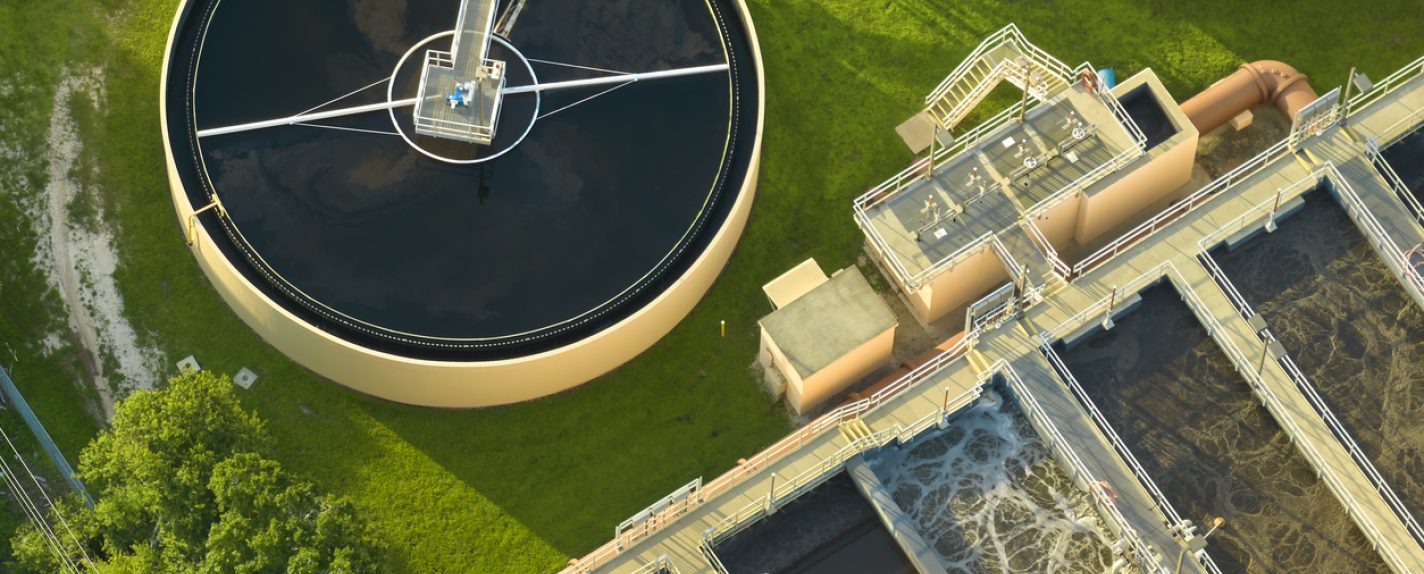POTWs Required To Test for PFAS

Newsletter Articles, PFAS
EPA has announced that 200-300 of the nation’s largest sewage agencies will be required to test for PFAS compounds in their influent, effluent, and sewage sludge/biosolids next year.[i] EPA has several options for using what will become publicly available sampling data, including setting new water quality standards in wastewater treatment permits, and for initiating regulatory enforcement.
EPA does not currently regulate PFAS in industrial waste discharges, nor does it restrict PFAS in effluent and biosolids. It issued draft aquatic life ambient water quality criteria for PFOS and PFOA in May 2022. Currently, the agency is accepting comments on the draft regulations. Meanwhile, EPA announced on March 26, 2024, its plan to submit an “Information Collection Request” (“ICR”) to the Office of Management and Budget (“OMB”) that would allow EPA to collect data on PFAS in wastewater from Publicly Owned Treatment Works (“POTWs”). EPA went out of its way to clarify that it does not currently plan to outright prohibit the use of sludge as fertilizer, as the agency recognizes it as an “important disposal method.”[ii] But if OMB approves the ICR, EPA will require 400 POTWs with the highest flow rates in the country to report “known or suspected” PFAS sources in the waste they receive, as well as describe how they manage the solid sludge that is leftover after the treatment process.[iii]
This first article in a two-part Marten Law series on EPA’s proposed actions to address PFAS in wastewater and biosolids will outline the agency’s proposed ICR, what would be expected of POTWs if the ICR is approved, and what POTWs can do in the interim to act on their PFAS concerns. The second part will: discuss the current federal and state-level regulatory landscape; summarize recent litigation involving biosolids contaminated with PFAS; provide a brief overview of liability risks POTWs may face in the near future, including federal claims under the Comprehensive Environmental Response, Compensation, and Liability Act (“CERCLA”), Resource Conservation and Recovery Act (“RCRA”), and Clean Water Act (“CWA”) and state-law claims based in tort liability, and; explain how EPA’s proposed ICR may affect future litigation on the topic.
Who is affected?
If EPA’s ICR is approved, it will require a subset of “large” POTWs across the United States to complete an electronic questionnaire.[iv] EPA will select which POTWs qualify as “large” based on geographic location and daily flow rate, as reported in the 2012 Clean Watersheds Needs Survey (“CWNS”).[v] EPA intends to select at least one POTW from each state and several POTWs from each EPA Region to ensure information collected reflects all regions of the United States. In developing the list of POTWs selected to complete the questionnaire, EPA will use information and data available from existing sources and solicit input from states, EPA Regions, POTW trade associations, and other stakeholders.[vi] EPA anticipates approximately 400 POTWs will be sent the initial questionnaire.
From the first set of 400, EPA will then select approximately 200-300 POTWs to collect and analyze samples. EPA will select this second group of POTWs based on information and data collected from the questionnaire.[vii] To avoid duplicative efforts, EPA may request POTWs with existing PFAS monitoring data submit the data to the agency instead of conducting additional sampling.
What action may be required?
Within 30 days of OMB approval, each of the approximately 400 POTWs selected to complete the questionnaire will receive a notification letter that will provide instructions, a link to an EPA webpage, and a facility-specific EPA Questionnaire ID and entry code.[viii]
POTWs selected to complete the mandatory electronic questionnaire will be asked to submit the following information:
- Facility name, location, municipal authority, and contact information,
- Applicable wastewater discharge and biosolids permit information and requirements,
- Quantities of wastewater transferred to the POTW and relative contribution of each type of influent (e.g., industrial, commercial, septage, residential, stormwater),
- Information on significant industrial users (“SIUs”) and known/suspected sources of PFAS discharges to the POTW,
- Wastewater treatment and management practices, including existing wastewater treatment technologies in place and the quantity and final destination of treated wastewater,
- Sewage sludge/biosolids treatment and management practices, including the annual quantity of solids generated and how these solids were handled, and
- Current PFAS monitoring requirements and laboratory capabilities.[ix]
EPA plans to use the information and data collected in the questionnaire to then select a smaller subset of 200 to 300 POTWs to participate in a two-phase sampling program. This subset will be contacted by EPA directly. EPA will coordinate with the selected POTWs to understand facility-specific sampling points and determine when sampling should occur. POTWs will be required to complete all sampling program requirements in accordance with a uniform sampling and analysis plan provided by EPA.
Phase 1 will require each selected POTW to collect and analyze one-time grab samples of industrial user effluent, domestic wastewater, POTW influent, and POTW effluent for PFAS. All Phase 1 samples must be analyzed with EPA Draft Methods 1633 (forty specific PFAS) and 1621 (adsorbable organic fluorine).[x] For each POTW selected, EPA anticipates specifying approximately 10 or fewer industrial users for which the POTW must collect and analyze effluent samples. EPA does not expect the total number of industrial users sampled to exceed 2,000 facilities.[xi] Phase 2 will require selected POTWs to collect and analyze one-time grab samples of sewage sludge/biosolids for PFAS and ancillary parameters. All Phase 2 samples must be analyzed with EPA Draft Method 1633 (forty specific PFAS) and also for ancillary parameters (metals Method 6010, total organic carbon Method 9060, and total solids, volatile solids, and fixed solids Method 2540).[xii]
What resources may be available to fulfill these requirements?
EPA does not anticipate facilities will need to generate new information or data to complete the questionnaire.
Prior to conducting the sampling program, EPA will provide POTWs with a generic sampling and analysis plan including specific requirements and procedures for sample collection, analysis, review, and submittal. POTWs selected by EPA to conduct sampling will be responsible for obtaining sampling supplies, collecting the required samples at the specified sampling points, contracting and coordinating with laboratories to conduct sample analysis, shipping samples to the laboratories, and submitting sample results to EPA in the specified format.[xiii] EPA plans to provide assistance to the POTWs selected for sampling prior to sample collection through virtual meetings and outreach, and during sample collection via a helpline.
EPA estimates the total burden to the POTWs for responding to the questionnaire and sampling program will be approximately $5.5 million.[xiv]
Why does EPA want this information?
EPA justifies its study by the fact that there is not currently a national, centralized public data source that contains the information and data it plans to collect via its ICR.[xv] The ICR fits within EPA’s broader Effluent Guidelines Program Plan 15, which outlines the agency’s intent to create a national dataset on industrial discharges of PFAS to POTWs, identify sources of PFAS wastewater discharged to POTWs, and assess the need for control measures upstream at the source.[xvi] The sampling data will primarily be used to identify and prioritize industrial point source categories where additional study or regulations may be warranted to control PFAS discharges. Data will also be used to inform upcoming risk assessments and the need for future regulations and guidance pertaining to the management of sewage sludge.
Will the information EPA collects be shared?
EPA will share all information not claimed as confidential business information within EPA, other state and federal agencies, and the public.[xvii] It intends to prepare publicly available summary versions of information and data it collects.[xviii] The information will likely also be shared with communities served by POTWs or located downstream from POTWs.
What is the timeline?
EPA will be accepting public comments on its initial ICR notice until May 28, 2024. Anyone wishing to comment may do so through the Federal Register website. The ICR could be approved by the end of year, or earlier.
The ICR has a rough implementation timeline and is also included in EPA’s broader PFAS Roadmap.
EPA has not yet established specific dates for distribution, response, and data collection for the questionnaire, but the agency intends to ensure facilities have at least 60 days to prepare and submit their responses. Following the questionnaire, EPA estimates the sampling process will take approximately 16 months. A more detailed table of expected timing is below.
Newsletter Articles, PFAS
Authors
The collection effort is consistent with EPA’s October 2021 PFAS Roadmap, which includes the agency’s plans to regulate levels of PFAS in biosolids.[xx] EPA is proceeding here in steps. The agency’s biosolids risk assessment for PFOA and PFOS is currently underway and expected to be published by the end of 2024. After the risk assessment is complete, EPA will engage in risk management to decide how to manage PFOA and PFOS in biosolids (eventually leading to a final rule/regulation). Since EPA is planning for its ICR questionnaire and sampling to take between 1.5-2 years, and it intends to use the collected data to inform its risk assessments and the need for future regulations and guidance, it may take at least 2 years for EPA to finally propose a rule concerning PFAS in biosolids. This timeline will likely extend further after accounting for the time allotted to the agency’s rulemaking procedure and process, thus delaying certain actions laid out in the Roadmap.
What can/should be done now?
The most important step concerned POTWs can take now is to submit comments on EPA’s proposed ICR before the public comment period closes on May 28, 2024.
POTWs may also consider asking their industrial users to proactively monitor or limit PFAS discharges to their treatment plants.
For more information about Marten Law’s PFAS and water quality work, please contact the attorneys in Marten Law’s water-quality practice, including Jeff Kray, James Tupper, and Emma Lautanen.
[i] 89 F.R. 20962, https://www.govinfo.gov/content/pkg/FR-2024-03-26/pdf/2024-06408.pdf.
[ii] Marc Heller, EPA: PFAS response won’t imperil sludge spreading on farms, E&E (Apr. 15, 2024), https://subscriber.politicopro.com/article/eenews/2024/04/15/epa-pfas-response-wont-imperil-sludge-spreading-on-farms-00152218.
[iii] 89 F.R. 20963, https://www.govinfo.gov/content/pkg/FR-2024-03-26/pdf/2024-06408.pdf.
[iv] Examples of “large” POTWs that may be selected to participate in the ICR based on the 2012 CWNS report include the Hyperion Wastewater Treatment Plant in Los Angeles County, the Point Loma Wastewater Treatment Facility in San Diego County, and the West Point Wastewater Treatment Plant in King County, among others. The draft questionnaire is available at: EPA, POTW Influent PFAS Study Questionnaire (March 2024), https://downloads.regulations.gov/EPA-HQ-OW-2023-0580-0002/attachment_2.pdf.
[v] EPA, Information Collect Request Supporting Statement: Part A (March 2024), pg. 2, https://downloads.regulations.gov/EPA-HQ-OW-2023-0580-0002/content.pdf.
[vi] Id. at 8.
[vii] Id. at 7.
[viii] Id. at 9.
[ix] Id. at 2-3.
[x] Id. at 7.
[xi] Id. at 2.
[xii] Id. at 7.
[xiii] Id.
[xiv] Id. at 21.
[xv] Id. at 7.
[xvi] EPA, Effluent Guidelines Program Plan 15 [Fact Sheet] (January 2023), https://www.epa.gov/system/files/documents/2023-01/ELG%20Plan%2015%20Fact%20Sheet.pdf.
[xvii] EPA, Information Collect Request Supporting Statement: Part A (March 2024), pg. 10, https://downloads.regulations.gov/EPA-HQ-OW-2023-0580-0002/content.pdf.
[xviii] Id.
[xx] EPA, PFAS Strategic Roadmap: EPA’s Commitments to Action 2021-2024 (October 2021), https://www.epa.gov/system/files/documents/2021-10/pfas-roadmap_final-508.pdf.
Authors
Stay Informed
Sign up for our law and policy newsletter to receive email alerts and in-depth articles on recent developments and cutting-edge debates within our core practice areas.


